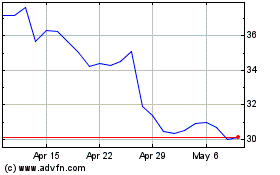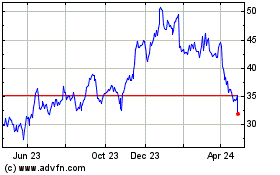Molex Inc’s (MOLX) earnings for the third
quarter of fiscal 2012 beat the Zacks Consensus by 4 cents, or
10.5%. Weaker-than-expected revenue pulled down results, despite
increasing cost efficiencies.
Revenue
Molex reported revenue of $837.1 million, which was down 2.4%
sequentially and 4.3% year over year, just within management
expectations of $830-860 million, or down 0-3% sequentially.
However, it fell short of the consensus expectation of around
$848.6 million. The telecom and consumer segments remained
under-color, with infotech growing slightly and other markets at a
stronger rate.
Revenue by End Market
Despite its relative weakness, the Data or
Infotech market (25% revenue share) emerged as the largest
contributor to revenue, growing 1.7% and 3.3% from the previous and
year-ago quarters. Molex stated that tablets and servers were the
major divers of the increase, with storage staying flat. The end of
the inventory correction and introduction of Romley from
Intel Corp (INTC) also helped Molex in the last
quarter.
Longer-term drivers in this market continue to be the migration
to SAAS 2.0 and 16GB fiber channel networks in the storage market,
as well as the popularity of tablets, notebooks and other MIDs. The
transition from copper to fiber-optic platforms will also drive
results, as Molex remains well-positioned with solutions for this
market.
Telecommunications dropped to second place, due
to the 17.4% sequential and 10.3% year-over-year decline in
revenue. The mobile phone segment within telecom was seasonally
softer as may be expected. The dynamics in this market are both
positive and negative for Molex at this point.
As smartphone penetration increases, it should benefit from its
position at leading manufacturers. At the same time, feature phones
(midrange devices) will continue to decline, which will be a
negative for Molex. The infrastructure side of the business
remained soft due to delayed spending by key players, made worse by
the supply chain in Asia that was impacted by the Chinese New Year.
However, management mentioned positive trends.
The long-term drivers for mobile phones are the growing adoption
of smartphones and the continued cramming of features into
increasingly smaller devices. Secular drivers of the infrastructure
business include increased Internet usage, increased volumes of
mobile devices of various kinds, more video being watched and
transmitted, as well as the adoption of cloud computing.
The automotive market brought in 18% of total
revenue, up 9.8% sequentially and 3.8% from the year-ago quarter.
Molex benefited from seasonal strength in North America and Europe
where production typically picks up due to fewer holidays. In Asia,
too, there was a pickup in production following the Chinese New
Year.
The increasing electronic content for safety systems,
powertrain, infotainment and telematics is a positive in
automobiles because it expands the market for Molex’s connector
technology. This and Molex’s exposure to China (where a large
amount of auto manufacturing has shifted) are secular drivers of
demand in this market.
Consumer Electronics dropped 7.8% sequentially
and 13.8% year over year to 17% of revenue. Although impacted by
the Chinese New Year, the weak pre-Christmas build enabled
inventory depletion, which therefore led to steady order growth
right through the quarter.
Comparison with the year-ago quarter was also tough, as Molex
benefited from economic recovery and government stimuli from all
over the world, particularly in Asia.
Molex should do well longer-term, as its customers introduce new
products targeting the BRIC countries -- as well as Vietnam and
Thailand, where growth is expected to be stronger than in other
parts of the world. Higher disposable income and increased
consumerism in developing countries are secular drivers of demand
in this market.
Industrial generated 14% of revenue, up 5.1%
sequentially and down 4.9% from last year. Around 65% of the
company’s segment revenue comes through distributors. The
sequential increase came after two quarters of decline, which Molex
attributed to more acceptable inventory levels in the channel, as
well as growing confidence at both OEMs and distributors.
The U.S. and Europe appear to be on the road to recovery, and
Asia is also strengthening (probably on account of rising wage
rates that are driving increased factory automation). The business
typically reflects global GDP growth rates.
The remaining 4% of Molex’s revenue came from
medical/military markets, which were up 30.1%
sequentially and 0.8% year over year.
Orders
Total orders were up 7.1% sequentially and 0.8% in the December
quarter. Backlog followed a similar pattern, increasing 10.1%
sequentially, while declining 9.4% from last year. The book-to-bill
jumped to 1.04, after staying below unity for three quarters.
Approximately 25% of Molex’s total orders were from the
data/infotech market, 23% from telecom market, 18% from auto, 17%
from consumer, 14% from industrial and 3% from medical/military.
All except telecom orders grew on a sequential basis, while all
except infotech declined from the year-ago quarter.
The order split between OEM/distribution/EMS was 49%-27%-24% in
the last quarter, compared to 52%-25%-23% in the December 2011
quarter. The OEM channel declined double-digits on a sequential
basis and was up slightly year over year. Distribution and EMS grew
from both the previous and year-ago quarters.
The Americas and Europe saw strong double-digit sequential
increase (15.1% and 23.6%, respectively) in orders. However, while
the Americas also grew double-digits on a year-over-year basis,
Europe declined. Asia/Pacific North was the weakest region,
declining 9.0% sequentially and 11.2% from last year. Asia/Pacific
South fared better, growing4.4% sequentially and declining 3.3%
year over year.
Margins
Molex reported a gross margin of 30.5%, down 18 basis points
(bps) sequentially and up 68 bps year over year. Despite the lower
volumes, Molex was able to leverage favorable product mix, which
almost totally offset adverse volume, commodity cost and currency
headwinds.
Operating expenses of $163.9 million were more or less flat with
the previous quarter’s $163.1 million. However, the operating
margin shrunk 73 bps sequentially to 11.6%. Most of the reduction
was attributable to higher operating costs as a percentage of
sales, although marginally higher cost of sales also
contributed.
Net Income
Molex’s pro forma net income was $67.4 million or 8.1% of
revenue compared to $66.7 million or 7.8% of revenue in the
December 2011 quarter and 71.0 million or 8.1% of revenue in the
March quarter of 2011. Our pro forma estimate for the last quarter
excludes losses related to unauthorized operations in Japan.
Including the special item, Molex reported a GAAP net income of
$64.9 million ($0.36 per share) compared to an income of $64.0
million ($0.36 per share) in the previous quarter and income of
$68.1 million ($0.39 per share) in the year-ago quarter.
Balance Sheet
Inventories were down 1.0%, with inventory turns flat at 4.3X.
DSOs went from 75 to around 79.
Molex ended with a cash and short term investments balance of
$622.5 million, up $3.9 million during the quarter. Cash generated
from operations was $138.9 million, up from $141.0 million in the
fiscal second quarter.
Capital expenses were $54.4 million, or 6.5% of revenue, up from
6.1% of revenue in the previous quarter. Molex also paid $26.2
million for repayment of short-term loans and $35.2 million for
cash dividends in the last quarter.
Guidance
Molex expects revenue of $870-900 million in the next quarter
(at the high end of the guided range), up 4-7% sequentially. The
pro forma EPS is expected to be 36 to 40 cents a share, assuming a
tax rate of 31%. The Zacks Consensus estimate for the fiscal fourth
quarter at the time of the earnings announcement was 41 cents,
better than the guided range.
Conclusion
Molex is a leading player in the fast-growing connector market,
with several secular growth drivers. Although some softness lingers
on in the telecom and consumer markets, the inventory correction is
over and orders are trending up.
Considering Molex’s strong position in the connector market, the
company should see the impact on its results. We note that despite
improving order trends, the guidance disappointed yet again. The
Zacks Rank for the shares is therefore #3, indicating a Hold
recommendation in the short term (1-3 months).
A few other factors need to be considered for the long term. For
instance, the nature of the business necessarily leads to some
commoditization, which in turn results in price erosion.
New product launches by customers and the evolving nature of the
served markets are offsetting positives that Molex should be able
to take advantage of given its market position. Therefore, our
long-term (3-6 month) recommendation on the shares is also
Neutral.
INTEL CORP (INTC): Free Stock Analysis Report
MOLEX INC (MOLX): Free Stock Analysis Report
To read this article on Zacks.com click here.
Zacks Investment Research
Intel (NASDAQ:INTC)
Historical Stock Chart
From Mar 2024 to Apr 2024

Intel (NASDAQ:INTC)
Historical Stock Chart
From Apr 2023 to Apr 2024
